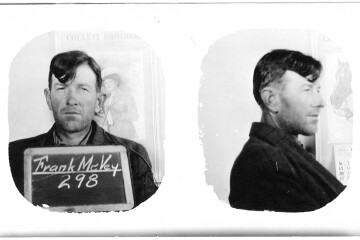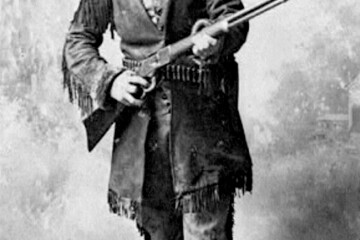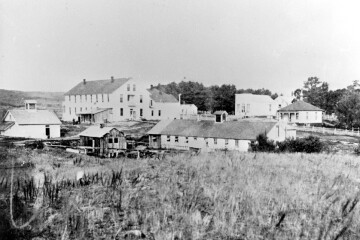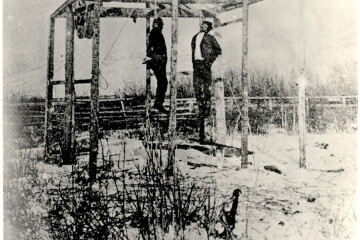History of Gallatin County Jails Revealed

Bozeman was not the original county seat for Gallatin County. In 1865, the first Montana Territorial Legislature established counties and designated Gallatin City, located near modern-day Three Forks, as the county seat. Gallatin City held that distinction for two years, but because of Bozeman’s rapid growth, a new election was held on Christmas Day in 1867, and voters agreed to move the county seat to Bozeman. Thus marked the beginnings of county government in the heart of our fair city.
At the time, government business was conducted largely in the homes of appointed and elected officials. In these early years, great responsibility fell to these officials to maintain law and order, and in 1869 the County Commissioners felt the need for a jail. Using monies pledged by local residents, county leaders constructed a new log jail in the 200 block of East Mendenhall Street for $487.50.
While the county jail was often, happily, without occupants, frontier conditions encouraged the presence of many unstable and irresponsible fortune seekers, as is still true today, crime follows population. Bozeman and Gallatin County experienced increasing violence with the most spectacular instance of “citizen’s justice” occurring February 1, 1873 when Vigilantes hanged two county prisoners, Z. A. Triplett and John W. St. Clair. The executioners broke into the log jail, and using an outdoor beef dressing rack for a scaffold, hanged the men at a slaughter house located on the corner of Main and Broadway. The open frame-work of the building used for the hanging and the dramatic image of the bodies hanging limply with hands tied behind their back was forever immortalized with an early morning photograph that still today shows up in social media.
The need for a courthouse steadily increased and in November of 1878 a ballot passed authorizing the construction of a new, $25,000 courthouse with a basement jail. W. H. Tracy donated property located at Main and Fourth Avenue and the project was completed in July of 1881. This first courthouse was hailed as the finest and best constructed public building in the Territory, with much credit going to the contractors, architect, commissioners, and the county at large. However, Gallatin County government quickly outgrew both the courthouse and the jail, which turned into an “unbelievably busy place.” In 1884, Commissioners spent $6017.10 to build an annex on the rear of the building, which provided additional offices, vault space, a grand jury room, a witness room and utility space.
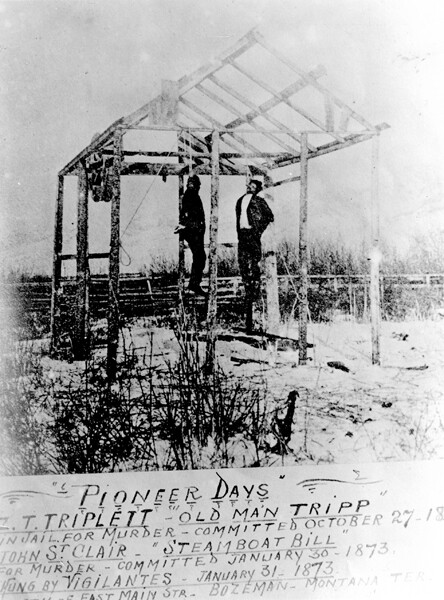
In 1883, ten years after the citizens’ adventure in justice, John A. Clark was found guilty of murder and was sentenced to hang, the execution was carried out on December 27 at 11:02 p.m., even though Mr. Clark’s last words professed his innocence. It was reported that his neck was broken by the fall and in ten and one-half minutes his pulse ceased to beat. It was further reported that nine minutes from the time he was pronounced dead, the body was lowered into the coffin and delivered to the undertaker. A short newspaper article followed the description of the hanging as something of a postscript. Written in a humorous vein, it noted a further development: “The body of John A. Clark was scarcely interred in what was generally supposed to be its last resting place, then a party of industrious and enterprising men proceeded to resurrect it, which they succeeded in doing in good style.” The article further reported at least three parties arrived in the cemetery on the same mission within a short time. A light reference was made attributing the grave robbing practice to a willingness of the local physicians of the time to purchase bodies for study purposes. Six months later in June of 1884 what remained of Clark’s skeleton was found in a farmer’s grove in a rough shipping box. Everyone was greatly relieved when the appointed county health officer took the remains for final burial.
Bozeman’s second legal hanging took place in the spring of 1906 when Lu Sing, a resident in the Bozeman Chinese colony, was hung for the “cold blooded murder” of local laundryman Tom Sing. Local newspapers reported the details of the back story feud that ended with Lu hitting Tom six times with a hatchet in front of witnesses. Mr. Sing was not as fortunate on the gallows as his predecessor Mr. Clark. His cause of death was an unpleasant strangulation that lasted close to fifteen minutes.
By 1910, steady population growth caused even greater crowding in the courthouse basement jail where space was also needed for government offices. A successful appeal to the electorate allowed the Commissioners to proceed with plans for a new jail to be built in the lot next to the courthouse at 317 West Main Street. With a budget of $35,000 the county employed local architect, Fred F. Willson, to prepare plans for the new building. His bastille-like concept matched the heavy appearance of the neighboring courthouse. The design included limited quarters for the sheriff, a deputy or a jailor, and a kitchen to serve the prisoners. This time, the ever-present gallows were located inside the building in a small multi-purpose room. Mr. Willson also included a tunnel that connected the new jail to the courthouse. This underground passageway was designed to keep prisoners secure while transporting them between the two buildings.

The new jail was virtually completed by December 2, 1911 and the prisoners moved in. The commissioners described the facilities with pride as “one of the best in the West”. Imagine their embarrassment when 20 days later, on December 22, six prisoners escaped in the early hours of morning. The escapees had observed the double locking method used to operate the doors, and seizing an opportunity, they escaped through the tunnel that connected the jail to the courthouse. Four of the men were captured in the month that followed, but the search was called off for the remaining two, citizens chalking it up to “good riddance”.
The third and last legal hanging in Gallatin County occurred on July 18, 1924 with the execution of Seth Orrin Danner. The background story on Mr. Danner’s crime is quite well documented via court transcriptions and newspaper accounts. The jury found Danner guilty of the murder of Mrs. John Sprouse, who was pregnant with her first child. Danner was also credited with killing Mr. Sprouse, but prosecutors only tried him for the one murder using his wife Iva as an eye-witness.
The gallows platform that hung Mr. Danner still resides in the old jail that is now home to the Gallatin History Museum. A patch on the wall marks the spot where ropes that released the platform pass into an adjoining room, where three men stood unseen, ready to drop the gallows. When the sheriff asked, “Dan, have you got anything to say?” To the twenty-two observers in the room, Mr. Danner responded:
“I want to tell you people that I hold no malice against any man. I have made my peace with God, and will go to him knowing that I am fully prepared; and I would like to see each and every one of you people to follow my example. I have nothing more to say. Goodbye, one and all.”



